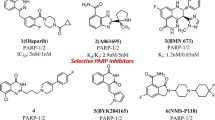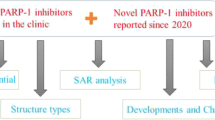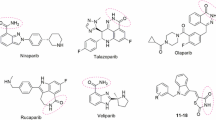Abstract
In recent times, inhibition of poly (ADP-ribose) polymerase (PARP) enzymes by pharmacological drugs has attracted much attention as an anticancer therapy. As reported, PARP-16 has been discovered as a novel anticancer target for small cell lung cancer, and that the inhibition of both PARP-16 and PARP-1 by talazoparib can increase the overall effectiveness of talazoparib in the SCLC treatment. In this study, we employed computational approaches to investigate the differential inhibitory potency of Talazoparib on PARP-1 and PARP-16. Talazoparib has excellent PARP-1 and PARP-16 binding activities, as revealed by the ΔGbind (total binding energy). Pp16-tpb had binding energy of −34.85 kcal/mol, while pp1-tpb had a binding energy of −26.36 kcal/mol. The binding activity of Talazoparib on both PARP-1 and PARP-16 was significantly influenced by van der Waal and electrostatic interactions. Correspondingly, according to the findings of this study, binding residues with total binding energy greater than 1.00 kcal/mol contributed considerably to the Talazoparib’s binding activities on PARP-1 and PARP-16. We believe the findings of this study will pave the way for developing dual targeting of PARP enzymes as a strategy for small-cell lung cancer treatment.






Similar content being viewed by others
References
Kalemkerian, G. P., & Schneider, B. J. (2017). Advances in small cell lung cancer. Hematology/Oncology Clinics of North America, 31(1), 143–156. https://doi.org/10.1016/j.hoc.2016.08.005.
Barayan, R., Ran, X., & Lok, B. H. (2020). PARP inhibitors for small cell lung cancer and their potential for integration into current treatment approaches. Journal of Thoracic Disease, 12(10), 6240–6252. https://doi.org/10.21037/jtd.2020.03.89. AME Publishing Company.
Rudin C. M., Brambilla E., Faivre-Finn C., & Sage J., small-cell lung cancer, Nature Reviews Disease Primers, 7, 1, 2021, https://doi.org/10.1038/s41572-020-00235-0.
Bernhardt E. B., & Jalal S. I., Small cell lung cancer, 2016, https://doi.org/10.1007/978-3-319-40389-2_14.
Kalemkerian, G. P. (2016). Small cell lung cancer. Seminars in Respiratory and Critical Care Medicine, 37(5), 783–796. https://doi.org/10.1055/s-0036-1592116.
Knelson, E. H., Patel, S. A., & Sands, J. M. (2021). Parp inhibitors in small‐cell lung cancer: Rational combinations to improve responses. Cancers, 13(4), 1–16. https://doi.org/10.3390/cancers13040727 .
Alhusaini, A., Cannon, A., Maher, S. G., Reynolds, J. V., & Lynam-Lennon, N. (2021). Therapeutic potential of PARP inhibitors in the treatment of gastrointestinal cancers. Biomedicines, 9(8), 1024 https://doi.org/10.3390/biomedicines9081024.
Rose, M., Burgess, J. T., O’Byrne, K., Richard, D. J., & Bolderson, E. (2020). PARP inhibitors: clinical relevance, mechanisms of action and tumor resistance. Frontiers in Cell and Developmental Biology, 8, 879 https://doi.org/10.3389/fcell.2020.564601. Frontiers.
Scarpa, E. S., Fabrizio, G., & Di Girolamo, M. (2013). A role of intracellular mono-ADP-ribosylation in cancer biology. FEBS Journal, 280(15), 3551–3562. https://doi.org/10.1111/febs.12290. John Wiley & Sons, Ltd.
Palve V. et al., The non-canonical target PARP16 contributes to polypharmacology of the PARP inhibitor talazoparib and its synergy with WEE1 inhibitors. Cell Chemical Biology, 2021, https://doi.org/10.1016/J.CHEMBIOL.2021.07.008.
Maddison R, Burgess JT, O'Byrne K, Richard D.J., & Bolderson E, PARP Inhibitors: clinical relevance, mechanisms of action and tumor resistance, Frontiers in Cell and Developmental Biology, 8, 2020, https://doi.org/10.3389/FCELL.2020.564601.
Ettl, J. et al. (2018). Quality of life with talazoparib versus physician’s choice of chemotherapy in patients with advanced breast cancer and germline BRCA1/2 mutation: patient-reported outcomes from the EMBRACA phase III trial. Annals of Oncology, 29(9), 1939–1947. https://doi.org/10.1093/ANNONC/MDY257.
Ryan, K. et al. (2021). Dissecting the molecular determinants of clinical PARP1 inhibitor selectivity for tankyrase. Journal of Biological Chemistry, 296, 1–13. https://doi.org/10.1074/JBC.RA120.016573.
Okunlola F. O., Olotu F. A., & Soliman M. E. S., Unveiling the mechanistic roles of chlorine substituted phthalazinone-based compounds containing chlorophenyl moiety towards the differential inhibition of poly (ADP-ribose) polymerase-1 in the treatment of lung cancer, https://doi.org/10.1080/07391102.2021.1951354.
Subair T.I., Akawa O.B., Soremekun O.S., Olotu F.A., & Soliman M.E.S., Insight into the therapeutic potential of a bicyclic hydroxypyridone compound 2-[(2,4-Dichlorophenyl)methyl]-7-hydroxy-1,2,3,4-tetrahydro-8H-pyrido[1,2-a]pyrazin-8-one as COMT inhibitor in the treatment of Parkinson’s disease: a molecular dynamic simulati, Chemistry & Biodiversity, 18, 9, 2021, https://doi.org/10.1002/CBDV.202100204.
Omolabi K.F., Iwuchukwu E.A., Odeniran P.O., & Soliman M.E.S., Could chroman-4-one derivative be a better inhibitor of PTR1? - Reason for the identified disparity in its inhibitory potency in Trypanosoma brucei and Leishmania major, Computational Biology and Chemistry, 90, 2021, https://doi.org/10.1016/J.COMPBIOLCHEM.2020.107412.
DA, C. et al. (2005). The Amber biomolecular simulation programs. Journal of Computational Chemistry., 26(16), 1668–1688. https://doi.org/10.1002/JCC.20290.
Kollman, P. A. et al.(2000). Calculating structures and free energies of complex molecules: Combining molecular mechanics and continuum models. Accounts of Chemical Research, 33(12), 889–897. https://doi.org/10.1021/ar000033j.
C.-α R. Parameter. (2009). Multiple molecular dynamics simulations of TEM β-lactamase: Dynamics and water binding of the Ω-loop. Biophysical Journal, 97(9), 2550–2558. https://doi.org/10.1016/j.bpj.2009.08.031.
Author information
Authors and Affiliations
Corresponding author
Ethics declarations
Conflict of interest
The authors declare no competing interests.
Human and animal rights
No Animals or Humans were used for studies that are the basis of this research.
Additional information
Publisher’s note Springer Nature remains neutral with regard to jurisdictional claims in published maps and institutional affiliations.
Rights and permissions
About this article
Cite this article
Mgoboza, C., Okunlola, F.O., Akawa, O.B. et al. Talazoparib Dual-targeting on Poly (ADP-ribose) Polymerase-1 and -16 Enzymes Offers a Promising Therapeutic Strategy in Small Cell Lung Cancer Therapy: Insight from Biophysical Computations. Cell Biochem Biophys 80, 495–504 (2022). https://doi.org/10.1007/s12013-022-01075-3
Received:
Accepted:
Published:
Issue Date:
DOI: https://doi.org/10.1007/s12013-022-01075-3




